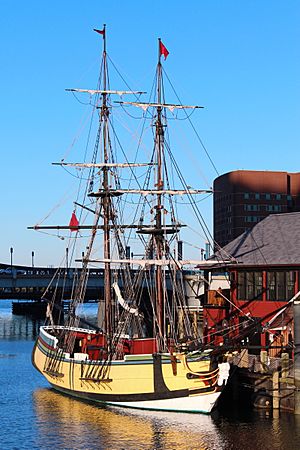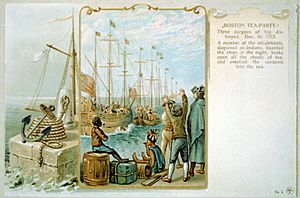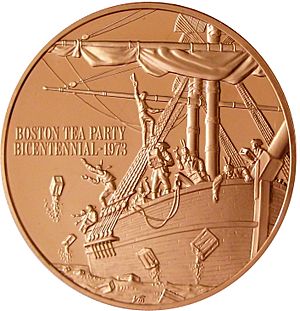Boston Tea Party facts for kids
Quick facts for kids Boston Tea Party |
|||
|---|---|---|---|
| Part of the American Revolution | |||
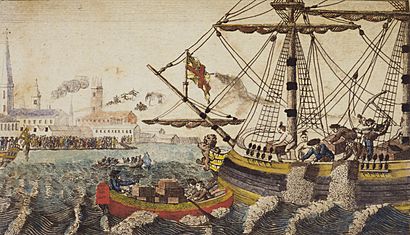
Boston Tea Party in The History of North America 1789
|
|||
| Date | December 16, 1773 | ||
| Location | |||
| Caused by | Tea Act | ||
| Goals | To protest British Parliament's tax on tea. "No taxation without representation." | ||
| Methods | Throw the tea into Boston Harbor but do no damage to anything else. | ||
| Resulted in | Intolerable Acts | ||
| Parties to the civil conflict | |||
|
|||
The Boston Tea Party was a famous political protest that happened in Boston, Massachusetts, on December 16, 1773. A group called the Sons of Liberty organized this event. They were very unhappy about a new law called the Tea Act. This law allowed the British East India Company to sell tea in the American colonies without paying taxes on it. However, American colonists still had to pay a tax when they bought the tea.
This tax was part of the Townshend Acts. American Patriots felt these taxes were unfair because they had no say in the British Parliament. They believed in "no taxation without representation." To protest, some people dressed as Native Americans. They went onto ships and threw many chests of tea into the Boston Harbor.
The British government reacted strongly to this protest. These events helped lead to the American Revolution, which started in 1775. The Boston Tea Party is a very important event in American history. Today, other protest groups sometimes use the name "Tea Party" to show they are following this historical protest.
Contents
Why Did the Boston Tea Party Happen?
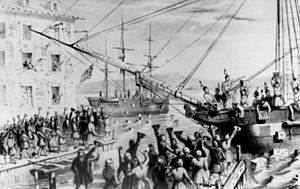
The British government had passed several tax laws that angered the American colonists. Two important ones were the Stamp Act of 1765 and the Townshend Acts of 1767. These laws meant that Britain could tax the colonies without the colonists having any representatives in the British Parliament. This led to the popular saying, "no taxation without representation."
One person who strongly disliked these taxes was John Hancock. In 1768, British officials took his ship, the Liberty. They accused him of smuggling. He was defended by John Adams, and the charges were eventually dropped. However, Hancock faced many more accusations later on.
The Tea Act and Its Impact
John Hancock helped organize a boycott of tea from China sold by the British East India Company. Because of this, the company's tea sales in the colonies dropped a lot. By 1773, the company was in serious debt. They had huge amounts of tea in their warehouses but couldn't sell it. This was partly because smugglers like Hancock were bringing in tea without paying taxes.
To help the company, the British government passed the Tea Act. This law allowed the East India Company to sell tea directly to the colonies. This meant they could sell tea at lower prices than colonial merchants and smugglers. However, the colonists still had to pay the Townshend Act tax on the tea.
Governor Hutchinson's Role
Most American ports stopped the British East India Company's tea ships from landing. Protesters successfully prevented tea from being unloaded in three other colonies. But in Boston, the British governor, Thomas Hutchinson, refused to send the tea back to Britain. He convinced the tea sellers, including his own sons, not to give in.
Governor Hutchinson wanted London to be tough on the Sons of Liberty. He planned to bring the tea into Boston by force, using British armed ships. If he had acted like other governors and let the ship owners deal with the colonists, the ships Dartmouth, Eleanor, and Beaver would have left the harbor without unloading any tea.
What Happened During the Boston Tea Party?
On December 16, 1773, the night before the tea was supposed to be unloaded, the Sons of Liberty took action. Three groups of 50 Boston residents, organized by Samuel Adams, left the Old South Meeting House. They headed to Griffin's Wharf. Three ships—the Dartmouth, the Eleanor, and the Beaver—were there, filled with hundreds of tea crates.
The men boarded the ships and began destroying the tea. By 9 pm, they had opened 342 crates of tea from all three ships. They threw all the tea into Boston Harbor.
Afterward, they took off their shoes and swept the ship decks clean. They made sure the ship's first mate knew that only the tea had been destroyed. The whole event was surprisingly quiet and peaceful. The next day, they even sent someone to fix a padlock they had broken.
After the Boston Tea Party, John Adams and many other Americans thought drinking tea was unpatriotic. Tea drinking became less popular during and after the Revolution. Americans started drinking coffee more often as their favorite hot drink.
How Did People React?
It's not clear if Samuel Adams helped plan the Boston Tea Party. But he quickly worked to tell people about it and defend it. He explained that the Tea Party was not a lawless act. Instead, he said it was a peaceful, important protest. He argued it was the only way left for people to protect their rights. The main problem was not the tax itself, but that the tax was passed without American input. The United States Congress later taxed tea from 1789 to 1872.
Some colonial and British officials were unhappy about the Boston Tea Party. For example, Benjamin Franklin said that the destroyed tea should be paid for. The British government punished the colonies by closing the port of Boston. They also put other strict laws in place, which the colonists called the "Intolerable Acts." In Britain, these were known as the Coercive Acts.
The Boston Tea Party was one of the key events that led to the American Revolution. The Tea Party and the strong British reaction helped increase support for the revolutionaries in the Thirteen Colonies. These revolutionaries eventually won their fight for independence.
Legacy and Modern Connections
American activists with different political views have used the Boston Tea Party as a symbol of protest. In 1973, for the 200th anniversary, a large meeting called for the impeachment of President Richard Nixon. It also protested oil companies during the oil crisis. After the meeting, protesters boarded a replica ship (a copy of an old ship) in Boston Harbor. They then dumped empty oil drums into the harbor.
In 1998, two conservative U.S. Congressmen put the federal tax code into a chest marked "tea." They then dumped it into the harbor.
The Boston Tea Party Museum is located on the Congress Street Bridge in Boston. It offers reenactments, a documentary, and many interactive exhibits. The museum has two replica ships from that time, the Eleanor and the Beaver. It also has one of only two known tea chests from the original event in its collection.
Interesting Facts About the Boston Tea Party
- Boston was one of four cities that was supposed to receive tea shipments from the British East India Company.
- The Beaver, one of the ships boarded by the Sons of Liberty, had been quarantined in the outer harbor for two weeks because of a case of smallpox.
- The tea that was destroyed originally came from China.
- George Washington did not approve of the Boston Tea Party. The event was not called a "party" until about 50 years later.
- The names of the people who took part in the protest were kept secret for many decades.
- One of the people in the raiding party was Thomas Melvill, the grandfather of Herman Melville, who wrote the famous book Moby Dick.
- Enough tea was dumped into the harbor to fill 18.5 million teabags.
- The only person hurt during the Boston Tea Party was John Crane. He was knocked out by a falling crate and people thought he was dead. He was reportedly hidden under wood shavings in a carpenter’s shop but woke up hours later.
Images for kids
-
This notice from the "Chairman of the Committee for Tarring and Feathering" in Boston denounced the people who bought tea as "traitors to their country."
See also
 In Spanish: Motín del té para niños
In Spanish: Motín del té para niños
- Timeline of United States revolutionary history (1760–1789)
- Prelude to the American Revolution
- Pine Tree Riot, 1772
- Philadelphia Tea Party, occurred soon after the Boston event, December 1773
- Burning of the Peggy Stewart, 1774
- Continental Association, 1774 boycott of British imports


